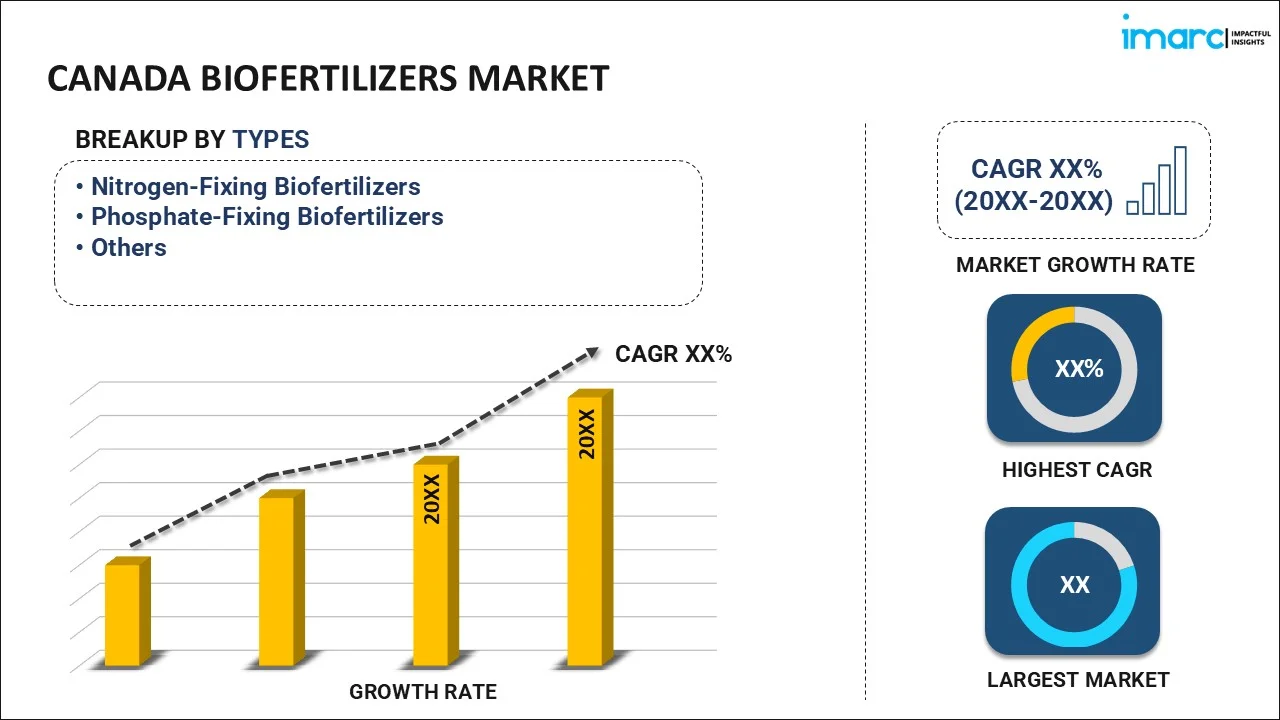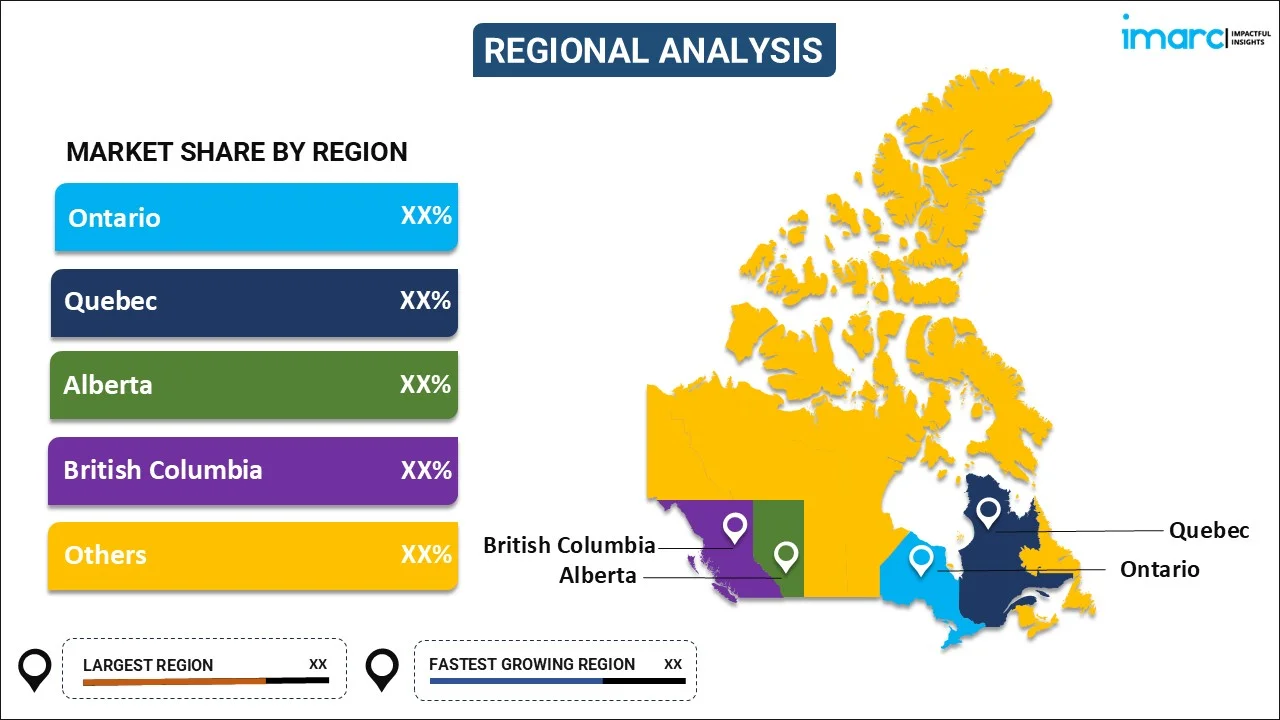
Canada Biofertilizers Market Size, Share, Trends and Forecast by Type, Crop, Microorganism, Mode of Application and Region, 2025-2033
Canada Biofertilizers Market Overview:
The Canada biofertilizers market size reached USD 69.70 Million in 2024. Looking forward, IMARC Group expects the market to reach USD 204.43 Million by 2033, exhibiting a growth rate (CAGR) of 11.60% during 2025-2033. The Canada biofertilizers market is witnessing steady growth driven by the increasing demand for organic food products. Rising government support, environmental concerns, and technological advancements fuel market expansion. Collaborations between manufacturers, research institutions, and government bodies are fostering innovation, enhancing product efficacy, and widening distribution channels are also contributing positively to the market growth.
|
Report Attribute
|
Key Statistics
|
|---|---|
|
Base Year
|
2024 |
|
Forecast Years
|
2025-2033
|
|
Historical Years
|
2019-2024
|
| Market Size in 2024 | USD 69.70 Million |
| Market Forecast in 2033 | USD 204.43 Million |
| Market Growth Rate (2025-2033) | 11.60% |
Canada Biofertilizers Market Trends:
Increase in Collaboration and Partnerships
Collaboration between the manufacturers, research institutions and government bodies in Canada plays an important role in the innovation and market expansion. By pooling resources and expertise these partnerships facilitate the development of tailored biofertilizer solutions suited to diverse crops and regional agro-climatic conditions. For instance, the Sustainable Canadian Agricultural Partnership (Sustainable CAP) is a $3.5 billion pact spanning 5 years (from April 1, 2023, to March 31, 2028), which includes federal, provincial, and territorial administrations focused on enhancing the agriculture industry's competitiveness, innovation, and resilience. It comprises $1 billion in federal initiatives and activities, together with $2.5 billion in cost-shared programs financed by federal, provincial, and territorial authorities, intended to enhance the sector's capabilities, tackle climate change, and promote science, research, and innovation. Agricultural research institutions contribute to scientific knowledge and field expertise while government bodies provide regulatory support and funding incentives. Manufacturers nowadays leverage these collaborations to enhance product efficacy, optimized formulation techniques and addresses specific challenges. This synergy fosters the creation of biofertilizers with improved performance, sustainability, and compatibility with modern farming practices. Ultimately, such partnerships not only spur innovation but also ensure the availability of effective and environmentally friendly biofertilizer solutions, thereby promoting the adoption of sustainable agriculture practices across Canada.
Rising Demand for Organic Products
The rising awareness regarding the detrimental impacts of synthetic fertilizers on both the environment and human health is steering consumers and farmers toward organic alternatives. For instance, in December 2020, the Canadian government announced the Strengthened Climate Plan, aiming to reduce GHG emissions from fertilizer application by 30% below 2020 levels by 2030. Agriculture accounted for 10% of Canada’s GHG emissions in 2019, with synthetic fertilizers contributing 12.75 Mt CO2e. Key sources included enteric fermentation, crop production, and on-farm fuel use. The plan seeks to address these emissions while encouraging improved nutrient management in the agriculture sector. This shift is mainly attributed to the rising demand for organic foods. Biofertilizers being inherently organic are experiencing a corresponding rise in popularity among cultural practitioners and consumers alike. Their appeal lies in their ability to enhance soil fertility and crop productivity without introducing harmful chemicals into the ecosystem. As sustainability nowadays becomes a paramount concern biofertilizers emerge as a viable solution aligning with the ethos of environmentally conscious farming practices. Recently, the government of Canada announced funding for the advancement of sustainable farming practices in the organic sector. This rising demand underscores a fundamental transformation in agricultural paradigms, emphasizing the important role of organic inputs in fostering both ecological resilience and human well-being.
Canada Biofertilizers Market Segmentation:
IMARC Group provides an analysis of the key trends in each segment of the market, along with forecasts at the country level for 2025-2033. Our report has categorized the market based on type, crop, microorganism, and mode of application.
Type Insights:

- Nitrogen-Fixing Biofertilizers
- Phosphate-Fixing Biofertilizers
- Others
The report has provided a detailed breakup and analysis of the market based on the agriculture type. This includes nitrogen-fixing biofertilizers, phosphate-fixing biofertilizers and others.
Crop Insights:
- Cereals and Grains
- Pulses and Oilseeds
- Fruits and Vegetables
- Others
A detailed breakup and analysis of the market based on the offering have also been provided in the report. This includes cereals and grains; pulses and oilseeds; fruits and vegetables, and others.
Microorganism Insights:
- Cyanobacter
- Rhizobium
- Phosphate Solubilizing Bacteria
- Azotobacter
- Others
The report has provided a detailed breakup and analysis of the market based on the farm size. This includes Cyanobacter, Rhizobium, Phosphate Solubilizing bacteria, Azotobacter and others.
Mode of Application Insights:
- Seed Treatment
- Soil Treatment
- Others
A detailed breakup and analysis of the market based on the offering have also been provided in the report. This includes seed treatment, soil treatment and others.
Regional Insights:

- Ontario
- Quebec
- Alberta
- British Columbia
- Others
The report has also provided a comprehensive analysis of all the major regional markets, which include Ontario, Quebec, Alberta, British Columbia and Others.
Competitive Landscape:
The market research report has also provided a comprehensive analysis of the competitive landscape. Competitive analysis such as market structure, key player positioning, top winning strategies, competitive dashboard, and company evaluation quadrant has been covered in the report. Also, detailed profiles of all major companies have been provided.
Canada Biofertilizers Market News:
- In February 2024, SureSource Agronomy, the Ontario-based company, debuts Canada's first biofertilizer made from cricket frass, showcasing at the Guelph Organic Conference. SureSource's Kickin' Frass, derived from insect byproducts, offers sustainable fertilizer choices with promising yields. Regulatory approval was secured following 2023 provincial funding and Vineland Research collaboration. Trials show frass outperforming commercial organic fertilizers in greenhouse lettuce and cucumber production. Product available as raw frass or processed crumble, providing flexibility and convenience for application.
- In December 2023, MustGrow Biologics Corp. is set to launch its bio-fertility product, TerraSante, in the United States after receiving registration in Washington state. This product, derived from mustard seed meal grown in Saskatchewan and Alberta, aims to enhance soil health and improve nutrient availability for high-value crops. With increasing demand for organic agricultural products, MustGrow plans to tap into the global market for bio-fertilizers, positioning itself for future expansion in the United States and beyond.
Canada Biofertilizers Market Report Coverage:
| Report Features | Details |
|---|---|
| Base Year of the Analysis | 2024 |
| Historical Period | 2019-2024 |
| Forecast Period | 2025-2033 |
| Units | Million USD |
| Scope of the Report |
Exploration of Historical Trends and Market Outlook, Industry Catalysts and Challenges, Segment-Wise Historical and Future Market Assessment:
|
| Types Covered | Nitrogen-fixing Biofertilizers, Phosphate-fixing Biofertilizers, Others |
| Crops Covered | Cereals and Grains, Pulses and Oilseeds, Fruits and Vegetables, Others |
| Microorganisms Covered | Cyanobacter, Rhizobium, Phosphate Solubilizing Bacteria, Azotobacter, Others |
| Modes of Application Covered | Seed Treatment, Soil Treatment, Others. |
| Regions Covered | Ontario, Quebec, Alberta, British Columbia, Others |
| Customization Scope | 10% Free Customization |
| Post-Sale Analyst Support | 10-12 Weeks |
| Delivery Format | PDF and Excel through Email (We can also provide the editable version of the report in PPT/Word format on special request) |
Key Questions Answered in This Report:
- How has the Canada biofertilizers market performed so far and how will it perform in the coming years?
- What is the breakup of the Canada biofertilizers market on the basis of type?
- What is the breakup of the Canada biofertilizers market on the basis of crop?
- What is the breakup of the Canada biofertilizers market on the basis of microorganism?
- What is the breakup of the Canada biofertilizers market on the basis of mode of application?
- What is the breakup of the Canada biofertilizers market on the basis of region?
- What are the various stages in the value chain of the Canada biofertilizers market?
- What are the key driving factors and challenges in the Canada biofertilizers market?
- What is the structure of the Canada biofertilizers market and who are the key players?
- What is the degree of competition in the Canada biofertilizers market?
Key Benefits for Stakeholders:
- IMARC’s industry report offers a comprehensive quantitative analysis of various market segments, historical and current market trends, market forecasts, and dynamics of the Canada biofertilizers market from 2019-2033.
- The research report provides the latest information on the market drivers, challenges, and opportunities in the Canada biofertilizers market.
- Porter's five forces analysis assist stakeholders in assessing the impact of new entrants, competitive rivalry, supplier power, buyer power, and the threat of substitution. It helps stakeholders to analyze the level of competition within the Canada biofertilizers industry and its attractiveness.
- Competitive landscape allows stakeholders to understand their competitive environment and provides an insight into the current positions of key players in the market.
Need more help?
- Speak to our experienced analysts for insights on the current market scenarios.
- Include additional segments and countries to customize the report as per your requirement.
- Gain an unparalleled competitive advantage in your domain by understanding how to utilize the report and positively impacting your operations and revenue.
- For further assistance, please connect with our analysts.
 Request Customization
Request Customization
 Speak to an Analyst
Speak to an Analyst
 Request Brochure
Request Brochure
 Inquire Before Buying
Inquire Before Buying




.webp)




.webp)












